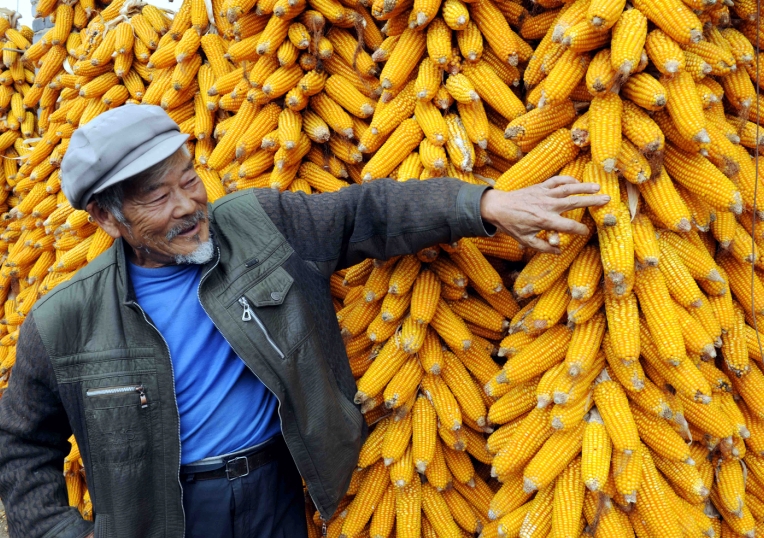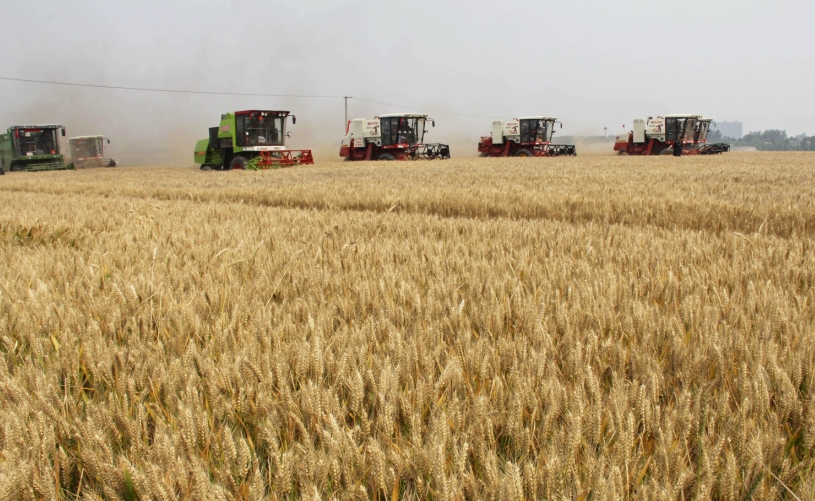| 
A Chinese farmer dries his crop of corn
When Lester R. Brown wrote his book Who Will Feed China? in 1994, he had a good understanding of what a big issue food security in the world’s most populous nation would become. In his book, the founder of the U.S.-based Worldwatch Institute warned the world that the combined effects of a spiraling population, shrinking cropland and water scarcity necessitated formulating a global development policy for the 21st century.
Reminding readers that Chinese account for 20 percent of the world’s population, Brown wrote: “In an integrated world economy, China’s rising food prices will become the world’s rising food prices. China’s land scarcity will become everyone’s land scarcity. And water scarcity in China will affect the entire world.”
Brown’s warning has thankfully not yet materialized – in China at least. Twenty years later, the Asian giant has proven to the world that it can feed itself – for now.
Top priority
For years, China has worried about maintaining its food security. On January 19, the country issued its first government policy document of this year. The annual document, which is known as the No.1 Central Document, underscores the importance of rural reforms, developing modern agriculture and maintaining agriculture as the foundation of the national economy. This is the 11th successive year China has focused its top policy document on agricultural development.
The document puts improving the national food security system on top of the reform agenda for 2014, and for the foreseeable future.
“Taking good control of its own bowl is a fundamental principle the government must stick to over a long period of time,” the document states.
An important aspect of China’s bid for food security is its goal of food self-sufficiency by relying mainly on domestic grain supply. Toward this end, the government has mandated that a minimum of 1.8 billion mu (120 million hectares) of arable land be set aside for farming to ensure food security. This mandate is more commonly known as the “red line.”
Despite the country’s process of rapid urbanization, which will unavoidably squeeze the area of farmland, China is strictly abiding by the red line principle.

Chinese farmers harvest the year’s crop
A grain contradiction
“It is natural for the Chinese Government to put so much focus on maintaining its food security as China’s grain production and consumption structure is facing a dilemma,” said Wei Feng, a financial observer.
Thanks to the promotion of agricultural sciences and technologies and increased government subsidies, China’s food production remains stable, with continuous growth in recent years. As of 2013, the country has witnessed growth in grain output for 10 successive years, with grain production exceeding 600 million tons in 2013. According to statistics released by the Ministry of Land and Resources, China has 135 million hectares of farmland, more than the previous estimation of 120 million hectares, providing more space for agricultural development.
However, despite the increase of grain production, customs statistics show the other side of the coin. Starting in 2004, China has been a net grain importer, and the imports keep increasing year by year. In 2012, China imported more than 70 million tons of grain, reducing its grain self-sufficiency rate to below 90 percent, lower than the 95 percent preset by the government.
Increasing grain production
“We should admit that food security is still a hidden peril in China at the current stage. Ensuring food security is always one of the most important tasks, as well as one of the greatest challenges in China,” Wei said.
Though China is now a net grain importer and its grain self-sufficiency rate continues to drop, China’s per-capita share of grain increased by 70 kg, compared with 20 years ago, when it was self-sufficient. Statistics show that the percapita grain consumption in China reached 500 kg per year in recent years, higher than the world record average.
“If everything goes well, the figure will continue to rise in the coming years,” Wei said. “The key issue is, where will the added amount of grain come from?”
According to Wei, if the added amount of grain comes from the international market, China’s grain self-sufficiency rate will continue to drop to below 80 percent. This percentage means the world’s most populated country will lose most of its capacity to control its domestic food price, which will instead be influenced primarily by the international markets and a few international grain giants.
“China should avoid such a disaster by further increasing its grain production,” Wei said.
Focus on quality
Besides emphasizing food sufficiency, the No.1 Central Document also focuses on the quality of grains. According to the document, the strictest standards, the most rigid supervision, the severest punishment and the harshest accountability system should be adopted to ensure food safety. Food security should put equal emphases on grain quantity and quality.
“Basically, China has solved the problem of food quantity and is now facing a more urgent problem: the quality of agricultural products and processed food, which is more related to people’s health,” said Zheng Fengtian, Professor of the School of Agricultural Economics and Rural Development of Renmin University of China.
According to him, the document puts equal emphasis on grain quantity and quality in maintaining food security, the greatest difference between it and previous annual documents, which placed more emphasis on grain quantity.
“This is the fundamental way to regain people’s confidence on agricultural products,” Zheng said.
For many years, China’s agricultural production has faced various threats such as fertilizer and pesticide pollution, which not only endangers grain quality, but also seriously pollutes water resources and soil, threatening the country’s ecological environment. The cadmium-laced rice scandal in 2013, a result of excessive fertilizer use, greatly destroyed public confidence in domestically produced rice.
“I am very glad to see that the Central Government has put more responsibility of food safety on local governments,” said Wang Dongyang, Vice President of the Institute of Food and Nutrition Development of the Ministry of Agriculture. Previously, when food safety problems occurred, individual operators were usually held accountable and penalized.
“When local governments take more responsibility, they will further strengthen supervision on food production and can better ensure food safety,” Wang said.
|